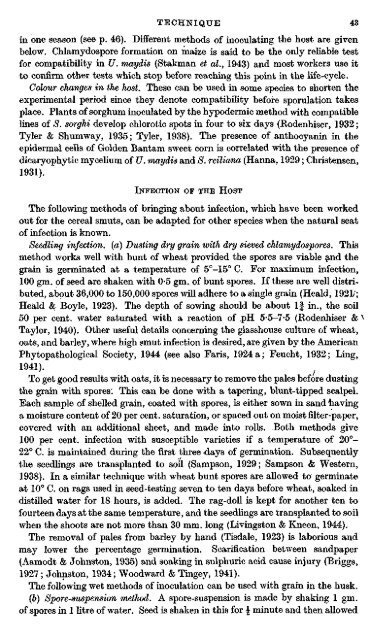nmm sP
nmm sP
nmm sP
You also want an ePaper? Increase the reach of your titles
YUMPU automatically turns print PDFs into web optimized ePapers that Google loves.
TECHNIQUE 43<br />
in one season (see p. 46). Different metliods of inoculating the host are given<br />
below. Chlamydospore formation on maize is said to be the only reliable test<br />
for compatibility in U. maydis (Stakman et al., 1943) and most workers use it<br />
to confirm other tests which stop before reaching this point in the life-cycle.<br />
Colour changes in the host. These can be used in some species to shorten the<br />
experimental period since they denote compatibility before sporulation takes<br />
place. Plants of sorghum inoculated by the hypodermic method with compatible<br />
lines of S. sorghi develop chlorotic spots in four to six days (Rodenhiser, 1932;<br />
Tyler & Shumway, 1935; Tyler, 1938). The presence of anthocyanin in the<br />
epidermal cells of Golden Bantam sweet com is correlated with the presence of<br />
dicaryophytic mycelium of U. maydis and S. reiliana (Hanna, 1929; Christensen,<br />
1931).<br />
INFECTION OF THE HOST<br />
The following methods of bringing about infection, which have been worked<br />
out for the cereal smuts, can be adapted for other species when the natural seat<br />
of infection is known.<br />
Seedling infection, (a) Dusting dry grain with dry sieved chlamydospores. This<br />
method works well with bunt of wheat provided the spores are viable ^.nd the<br />
grain is germinated at a temperature of 5°-15° C. For maximum infection,<br />
100 gm. of seed are shaken with 0-5 gm. of bunt spores. K these are well distributed,<br />
about 36,000 to 150,000 spores will adhere to a single grain (Heald, 192L';<br />
Heald & Boyle, 1923). The depth of sowing should be about If in., the soil<br />
50 per cent, water saturated with a reaction of pH 5-5-7-5 (Rodenhiser & ^<br />
Taylor, 1940). Other useful details concerning the glasshouse culture of wheat,<br />
oats, and barley, where high smut infection is desired, are given by the American<br />
Phytopathological Society, 1944 (see also Faris, 1924 a; Feucht, 1932; Ling,<br />
1941). ^<br />
To get good results with oats, it is necessary to remove the pales before dusting<br />
the grain with spores; This can be done with a tapering, blunt-tipped scalpel.<br />
Each sample of shelled grain, coated with spores, is either sown in sand taving<br />
a moisture content of 20 per cent, saturation, or spaced out on moist filter-paper,<br />
covered with an additional sheet, and made into rolls. Both methods give<br />
100 per cent, infection with susceptible varieties if a temperature of 20°-<br />
22° C. is maintained during the first three days of germination. Subsequently<br />
the seedlings are transplanted to soil (Sampson, 1929; Sampson & Western,<br />
1938). In a similar technique with wheat bunt spores are allowed to germinate<br />
at 10° C. on rags used in seed-testiag seven to ten days before wheat, soaked in<br />
distilled water for 18 hours, is added. The rag-doll is kept for another ten to<br />
fourteen days at the same temperature, and the seedlings are transplanted to soil<br />
when the shoots are not more than 30 mm. long (Livingston & Kneen, 1944).<br />
The removal of pales from barley by hand (Tisdale, 1923) is laborious and<br />
may lower the percentage germination. Scarification between sandpaper<br />
(Aamodt & Johnston, 1935) and soaking in sulphuric acid cause injury (Briggs,<br />
1927 ; Johnston, 1934; Woodward & Tingey, 1941).<br />
The following wet methods of inoculation can be used with grain in the husk.<br />
(6) Spore-suspension method. A spore-suspension is made by shaking 1 gm.<br />
of spores in 1 litre of water. Seed is shaken in this for ^ minute and then allowed

















